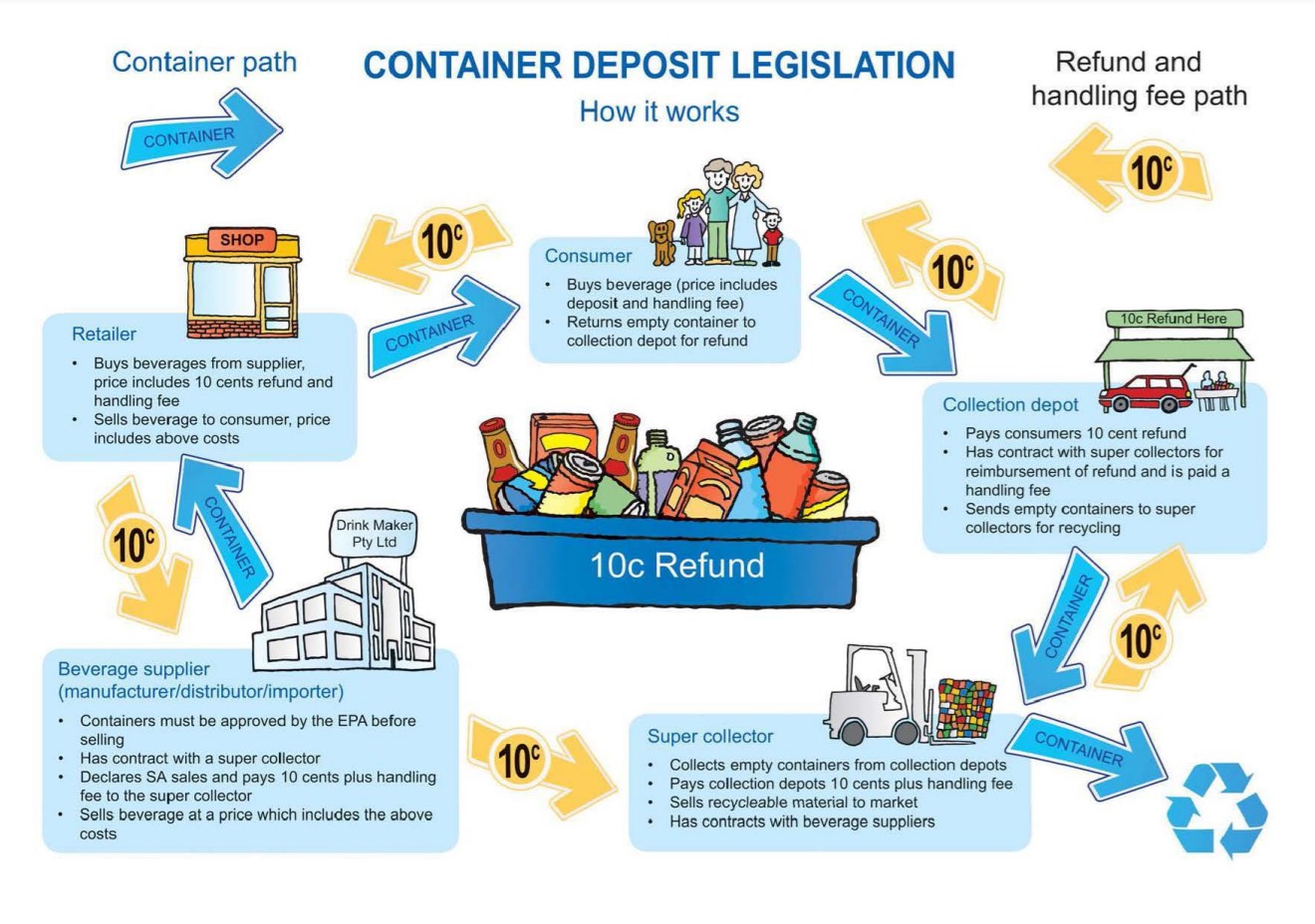| Law Summary | Environment Protection Act 1993, Part 8, Division 2: Beverage Containers. | ||||||||||||||||||||||||||||||||||||||||||||||||||||||||
| Purpose of Legislation | "This Division establishes a litter control and waste management system for beverage containers through a regulatory scheme." [1] | ||||||||||||||||||||||||||||||||||||||||||||||||||||||||
| Date Implemented | Deposit legislation implemented in 1975. Integrated with Environment Protection Act in 1993 | ||||||||||||||||||||||||||||||||||||||||||||||||||||||||
| Beverages Covered |
Beverages ≤250mL [2]:
Beverages ≤1L:
Beverages ≤3L:
|
||||||||||||||||||||||||||||||||||||||||||||||||||||||||
| Beverages Not Covered |
Glass containers for wine and spirits will be covered in mid-2027. They are currently not covered. [3] |
||||||||||||||||||||||||||||||||||||||||||||||||||||||||
| Amount of Deposit |
10¢ AUD |
||||||||||||||||||||||||||||||||||||||||||||||||||||||||
| Fees and Taxes |
Annual collection depot operation fee [4]:
|
||||||||||||||||||||||||||||||||||||||||||||||||||||||||
| Program Success [5] |
|
Details
How South Australia's Deposit System Works
The Recyclers of South Australia have put together a detailed chart on their website explaining the steps in the deposit-return process. This is a duplicate version.
|
Step 1 |
Wholesaler supplies to retailers. The 10 cent deposit and an agreed handling fee is included in the wholesale price of the beverage. |
The deposit and handling fee is retained by the beverage filler or their agent who operates as the collection co-ordinator. This is held until the deposit containers are returned to them to be recycled. |
|
Step 2 |
Supply consumers. The 10 cent deposit and handling fee is included in the retail price paid by the consumer for the beverage. | |
|
Step 3 |
Return deposit containers to recycling depot for full payment, 10 cent deposit. | |
|
Step 4 |
Sort the containers by material and responsible agent, ie. Glass, aluminium, PET, into containers for return to the collection co-ordinators. Marine Stores Pty Ltd Lion Nathan / SA Brewing and Cooper products Statewide Recycling |
Cans - Back to Marine Stores Pty Ltd
Cans - Back to Visy Recycling (Can Co-ordinator) Cans, PET, liquid paperboard , other plastics and steel cans back to Statewide Recycling the collection co-ordinator.
|
| Collection Co-ordinator |
Once containers are sorted, they are sent back to the collection co-ordinator, agent for the recycling of material and auditing. Collection co-ordinators are: Statewide Recycling |
Collection co-ordinators pay the Recycling depot back the 10 cent deposits which they paid out to the consumer in step 3, plus an agreed handling fee. |
*While still approved as a super collector/collection co-ordinator, Flagcan Distributors is not currently operating in the system.

History
In 2008, the deposit/refund amount was changed to 10¢ per container, regardless of "Category" (Previously it had been 10¢ for Category A and 5¢ for Category B). According to the South Australia EPA, "The State Government has increased the deposit amount on beverage containers to encourage more South Australians to recycle. By increasing the incentive to recycle, less litter will be seen on our streets and less waste will be sent to landfill." South Australia thus became the first Australian state to enact bottle deposit legislation.
The Northern Territory was the second Australian territory to enact a deposit law, which was modeled on the South Australia law. The two territories signed an agreement in 2011 to align their container deposit schemes. The agreement also addresses the issues of minimizing border fraud and increasing recovery and recycling while reducing litter. [6]
In 2019, Southern Australians were invited to give feedback on how to improve the CDS by the Government of South Austalia. Feedback could be given through completing a survey, emailing, or physically mailing a response, as well as participating in a discussion on the government's online consultation hub, YourSAy. Online feedback reception ended in February 2019. Three meetings were held between the EPA and key stakeholders from February to September 2019. The EPA Board hosted its annual CDS summit in 2019 to facilitate discussion on ways to reform and improve the CDS. A consultation summary report of the review was released in August 2019. Further consultation occurred in 2021 and 2022. Draft legislation is expected to be released for public review in 2023.
More Information
Beverage containers do not need to be sorted prior to taking them to a collection depot. Currently, 127 depots operate in South Austalia. To find one, please refer to the EPA's list of approved collection depots. All beverages covered by the CDS in South Australia must carry an appropriate refund marking. An example is shown below:

There are two categories of beverage containers, A and B. Category A containers are approved to be returned for refund to any outlet where that beverage is sold; these comprise less than 1% of beverages sold. Category B containers are approved to be returned to collection depots for a 10-cent refund. Both categories have their own approved refund markings. [7] Beverages may also use common refund marking, which is approved refund marking for use in all Australian jurisdictions operating a container deposite scheme, namely Northern Territory, New South Wales, Queensland South Australia and the Australian Capital Territory.
Since its inception, South Australia's deposit scheme has seen consistently high return rate, with overall return rates above 65%. In FY23-24, over 660 million containers were returned, an equivalent of $66 million in refunds. [8]

Footnotes
[1] Environmental Protection Act 1993 pt. 8, div. 2, Beverage Containers. (SA).
[2] "List of beverages covered by the Environment Protection Act 1993." Environment Protection Agency - South Australia.
[3] "NSW, SA to add wine and spirits to container deposit schemes by mid-2027." Drinks Trade. September 5, 2025.
[4] "Collections Depots Guidelines." Environment Protection Agency - South Australia. Last updated July 2020.
[5] "Beverage Container Return Rates." South Australia Environmental Protection Authority. Last updated 2024.
[6] "Historic agreement to coordinate recycling in SA and NT." Legislative Assembly of The Northern Territory. December 6, 2011.
[7] "Industry Operators." Environment Protection Agency - South Australia. Last updated February 2020.
[8] See Footnote 5.
Last updated on September 5, 2025.